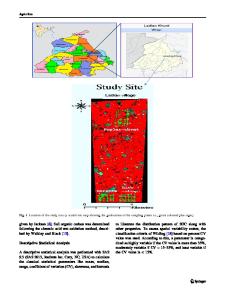Modelling Soil Organic Carbon Changes Under Different Maize Cropping Scenarios for Cellulosic Ethanol in Europe
- PDF / 3,865,770 Bytes
- 9 Pages / 595.276 x 790.866 pts Page_size
- 2 Downloads / 359 Views
Modelling Soil Organic Carbon Changes Under Different Maize Cropping Scenarios for Cellulosic Ethanol in Europe E. Lugato & A. Jones
# The Author(s) 2014. This article is published with open access at Springerlink.com
Abstract The utilization of crop residues in the production of second-generation biofuels has the potential to boost the bioenergy sector without affecting food commodity prices. However, policies leading to large-scale biomass removal should carefully balance the consequences, both environmental and in terms of emissions, on soil organic carbon (SOC) stocks depletion. Using a recently developed simulation platform, SOC changes were estimated at European level (EU + candidate and potential candidate countries) under two scenarios of low (R30) and high (R90) maize stover removal for cellulosic ethanol production (i.e. 30 and 90 % of stover removal, respectively). Additionally, mitigation practices for SOC preservation, namely the introduction of a ryegrass cover crop (R90_C) and biodigestate return to soil (R90_B), were explored under the highest rate of stover removal. The results showed that 15.3 to 50.6 Mt year−1 of stover (dry matter) would be potentially available for ethanol production under the lower and high removal rates considered. However, largescale exploitation of maize residues will lead to a SOC depletion corresponding to 39.7–135.4 Mt CO2 eq. by 2020 (under R30 and R90, respectively) with greater losses in the long term. In particular, every tonne of C residue converted to bioethanol was predicted to have an additional impact on SOC loss almost ranging from 0.2 to 0.5 CO 2 eq. ha−1 year−1, considering a continuous biofuel scenario by The views expressed in this paper are purely those of the writers and may not in any circumstances be regarded as stating an official position of the European Commission. Electronic supplementary material The online version of this article (doi:10.1007/s12155-014-9529-2) contains supplementary material, which is available to authorized users. E. Lugato (*) : A. Jones European Commission, Joint Research Centre, Institute for Environment and Sustainability, Via E. Fermi, 2749, 21027 Ispra, VA, Italy e-mail: [email protected]
2050. The mitigation practices evaluated could more than halve SOC losses compared to R90, but not totally offsetting the negative soil C balance. There is a pressing need to design policies at EU level for optimum maize biofuel cultivations that will preserve the current SOC stock or even generate C credits. Keywords Soil organic carbon . Maize stover . Biofuel . Crop residues . Modelling
Introduction One of the goals of the European Union (EU) climate and energy package, known as the “20-20-20” targets [1], is to raise the share of energy production from renewable resources to 20 % by 2020. Under this commitment, the conversion of land to bioenergy and biofuel crops has started to increase rapidly and is expected to continue, since an additional 20 Mha is predicted to be required across Europe to support the bioenergy
Data Loading...











